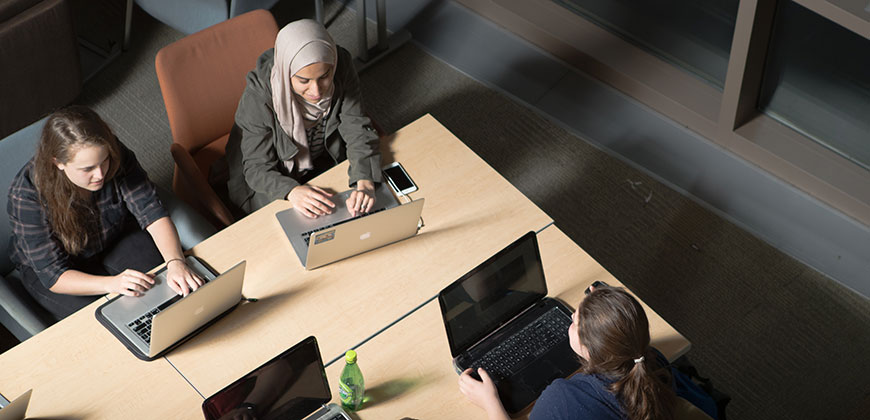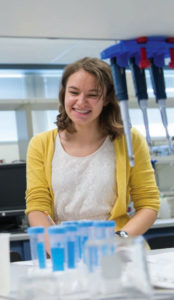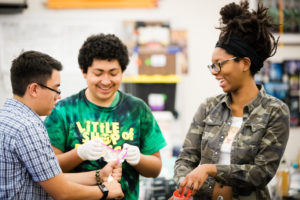
Students in the Association for Computing Machinery – Women.
This article originally appeared in the College of Natural Sciences’ Elements magazine. Read the full issue here.
When Chris Wilcox, a special assistant professor in computer science at Colorado State University, first looked out over his sophomore-level course, he noticed something striking: only about one in 10 of his students were women. With a university – and state and national – population that is roughly half female, it didn’t take a software engineer to see that something in the code was broken.
Rather than accepting the disparity, he was inspired to do something about it. “I wanted to find out what was going on,” he says. His efforts joined many ongoing initiatives from the university, college, and other departments to improve diversity.
The landscape in the sciences has shifted substantially in recent decades. But the country still has a long way to go. Women currently make up just a quarter of the STEM (science, technology, engineering, and math) workforce. Racially and ethnically diverse minorities are also often underrepresented. The College of Natural Sciences has been making significant strides, not just in increasing numbers of students of diverse backgrounds, but also in supporting everyone at the college – whether student, faculty, or staff member.
“We have a responsibility, not just to our college and university communities, but also to our state, country, and to the sciences themselves to take a deep look at this issue and find ways to address it,” says Jan Nerger, dean of the college.
Building better sciences
The big, challenging, and often unspoken question in this area is: Why? Why strive for greater diversity? There is, of course, the moral call to ensure that everyone, regardless of socioeconomic status, gender, ethnicity, race, geographic background, or belief system, can pursue their personal passions – and feels welcome in doing so.
In fields dominated by data, it is easy to get hung up on numbers. A clear goal would be to cultivate a college whose student and faculty population closely mirrors the population of Colorado or the country. And to be sure, such an achievement would be a wonderful success, says Arlene Nededog, director of inclusion for the college. But there is a broader reason for wanting to build diversity in the sciences – beyond numbers, beyond an equitable aim. “It’s been demonstrated that when you create a more diverse team, you’re more innovative, you’re more creative, and you’re more productive,” Nededog says. And those are crucial elements to moving science forward.
“Scientific progress relies on creative thinking, diverse thinking,” Nerger says. “When you have a group – and a field – that is truly diverse, you are really creating the best possible environment to make world-changing discoveries.”
Organic growth
In 2009, when Nerger was appointed interim dean, she had already been with the college for two decades – beginning as an assistant professor in the psychology department in 1989. She knew firsthand that the college and its sciences would benefit from a better-supported female faculty. So, together with Ellen Fisher, a professor in the chemistry department, they created Women in Natural Sciences. Female faculty who join the college automatically become members of the group, which provides research and travel support as well as mentorship. The group now includes more than 90 members.
Additional support in the college has long come in myriad forms, including the Native American Women in Science Scholarship, the Computer Science Inclusion and Excellence Scholarship, and student groups, such as Women in Physics, which is open to all students. Additionally, the college has been the birthplace of campus-wide programs, including CSU’s chapter of SACNAS (the group formerly known as Society for Advancement of Chicanos and Native Americans in Science); Out in Science, Technology, Engineering, and Mathematics; and Students as Leaders in Science.
“These are all pieces of the puzzle that we are now able to bring into a more comprehensive whole,” says Nededog, whose position was created in 2015 and who works closely with CSU’s President’s Commission on Diversity and Inclusion. Nerger also has her sights set on the big picture – and the long term. “Establishing organic, authentic diversity comes from all sides: faculty recruitment and backing, student enrollment and support, and institutional growth,” she says. “These things take time and thought.”
The human element
As diversity-focused efforts are proving successful in truly expanding the college and its fields to more people, Nededog is quick to point out that the experience of students and faculty are not, of course, limited to a particular identity. Life on campus is much richer and more nuanced.

Bolstering a sense of community and belonging is crucial for everyone’s success. That is why Nededog is looking at the college’s efforts to improve diversity holistically. Alongside targeted organizations and scholarships, she also ranks departmental clubs, faculty connections, undergraduate research, and the College of Natural Sciences Learning Community as critically important in establishing the long-term diversity initiatives of the college.
The essential element in all of this is the human element. The sciences are often portrayed as fields where individual brilliance is paramount, and work is done in isolation – often with little direct impact on the actual day-to-day life of others. This stereotype, says Nerger, “cannot be further from the truth. Science is collaborative by its very nature – in fact, it requires teamwork,” she says. “The problems we face today are too complex to solve alone. And by tackling them together, we help people – now and down the road.”
A new effort in computer science is already showing fruits of this sort of thoughtful labor. Professor Adele Howe is championing the radical idea of proactive communication, coupled with open honesty. For the past few years, the department has written letters, and female undergraduates have made phone calls to women admitted into computer science. In these communications, the current students acknowledge that they, as women, are still in the minority among majors. But, they emphasize, the department at CSU provides support and community (though the Association for Computing Machinery — Women club, for example). And that they, themselves, will be there as peers and mentors.
Since these letters began going out – and since the advent of dedicated scholarships and more inclusive teaching practices – female enrollment has begun climbing out of that 10 percent rut. Some 17 percent of entering freshmen in the department this year are women. And, notes Wilcox with pride, the top three performers in his challenging sophomore course – the one previously stuck at 10 percent female – are all women.
Supporting early passions
By the time many high schoolers are selecting colleges and majors, however, they have already made up their minds about what they want to study – or, perhaps, what they should study.That is why the college’s diversity efforts aren’t stopping with undergraduates – or even high school seniors. A passion for – and confidence in – the sciences begins early, says Nerger. “To paraphrase Carl Sagan: Every child is born a natural scientist,” she says. “It is only experience that teaches them that they cannot, or should not, continue. I’m afraid our society could do a much better job of telling everyone that if they want to, they can succeed in the sciences.”

Indeed, research by two College of Natural Sciences faculty members published this summer in the journal PLOS ONE shows that about two-thirds of both boys and girls in the fourth grade report an interest in science. However, of those who graduate college with a degree in a STEM field, only about one-third are women.
Jess Ellis, an assistant professor in the CSU mathematics department, Bailey Fosdick, an assistant professor in the statistics department, and their coauthor from San Diego State University, are tracking this drop-off. “When women are leaving, it is because they don’t think they can do it,” Fosdick says – despite their grades being the same as those of their male counterparts. So the question becomes, Ellis says, “What about the climate is making them lack that sense of belonging or sense of confidence in themselves?” Next, the researchers will be examining data from students of diverse ethnic and racial backgrounds that are underrepresented in the STEM majors.
These data are yet more inspiration to continue the work of the Little Shop of Physics, which brings hands-on science experiments to classrooms around the state and around the world; the Education and Outreach Center, which partners with researchers on campus to translate their research into portable kits for classroom teachers; and other programs that reach underserved and underrepresented students locally – and globally.
“We are here to conduct cutting-edge research and to educate the next generation of science-minded leaders,” Nerger says. “The best way to do that is to make sure there is a place for everyone at the bench – from grade school through a fulfilling career. In doing that, as a society, we have nothing to lose and everything to gain.”